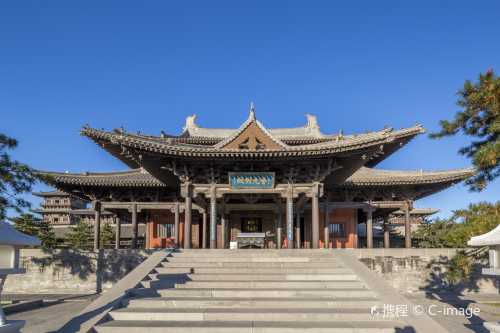Popular Trip Moments
Shanxi is so "earthy" it gets mocked? But its cultural depth leaves the nation speechless | Shanxi Datong Zhaojia Village Apricot Picking Guide: A Sweet Summer Encounter | The Filming Location of Black Myth: Wukong - Longxing Temple's Thousand-Year-Old Pagoda | Shanxi | 4 Days & 3 Nights | July Off-the-Beaten-Path Travel: Budget-Friendly Trips to Three Cozy Cities | Encounter a rendezvous of lake and sunlight at Meiman | Datong | Datong Volcano Group National Geological Park | 🕰 Datong: Spiritual & Architectual Wonders ! | A museum where you can stay | If you want to sleep somewhere different, be sure to come to Yunxiju | Datong 2 Days Travel Guide | Flying Rainbow Tower at Guangsheng Temple | Check-in! A must-stay homestay in Datong Ancient City - Qingyuan Xiaozhu (Datong Ancient City Wall Huayan Temple Branch) | Shanxi is not just about Datong, Linfen has even greater potential—here’s a three-day, two-night guide for you | Help! This homestay in Datong Ancient City is a magazine-worthy photo spot with every shot! The wabi-sabi style is absolutely stunning! | A City Wall, Half an Epic of Border History | Discover the beauty of Yanggao: Travel guide to avoid pitfalls | Departing from Beijing | Challenge to Travel Out Every Week: Datong Second Visit Full Record | Hanging Temple of Mount Heng | New Summer Vacation Spot for Kids! LUX* 7th Mansion | Just got back from Datong, here’s some blunt truth | Pillows of Bamboo, Views Like Paintings: Step into the Elegant Life of the Song Dynasty | Datong Summer Retreat Gem: Encounter a Refreshing 21°C Summer | For this window view... I flew all the way to Datong!!! | Time Travel Adventure! Must-Visit Guide to Hunyuan State Office Inn! | Datong Yungang Jianguo Hotel, High Value for Money | Shanxi Datong: A Journey Through Millennia | Prime accommodation in Datong Ancient City, unlock an extraordinary travel experience | Castle Deluxe Twin Room | Weekend Short Trips by High-Speed Rail to Seven Stunning Cities
Recommended Attractions at Popular Destinations
Attraction near Bangkok | Attraction near Manila | Attraction near Tokyo | Attraction near Taipei | Attraction near Hong Kong | Attraction near Seoul | Attraction near Kuala Lumpur | Attraction near Los Angeles | Attraction near Shanghai | Attraction near New York | Attraction near Shenzhen | Attraction near Osaka | Attraction near Singapore | Attraction near London | Attraction near Guangzhou | Attraction near San Francisco | Attraction near Beijing | Attraction near Macau | Attraction near Bali | Attraction near Jakarta | Attraction near Paris | Attraction near Ho Chi Minh City | Attraction near Istanbul | Attraction near Phuket | Attraction near Chicago | Attraction near Seattle | Attraction near Toronto | Attraction near Orlando | Attraction near Cebu | Attraction near Chiang Mai
Popular Restaurants in Datong
Fenglinge | ZINI 369 CULIANG JI | 龙聚祥烧麦馆(鼓楼店) | KAI GE JIU LOU | LAO YE MIAO FENG WEI MEI SHI FU | Huayuanda Restaurant | Kaige Restaurant (caochangcheng) | 红旗大饭店(火车站店) | Northern Wei family feast | Howard Johnson Golden Land Hotel Chinese Restaurant | 王府至尊酒店·自助餐厅 | 王府至尊酒店中餐厅 | Caijia Restaurant (yong'andajie) | 凯鸽火锅城(迎宾西路店) | 紫泥砂锅居(龙港苑店) | Jinbeilaochu | 紫泥369粗粮季(南环店) | 凤临阁·味庄 | 凯鸽酒楼(水泉湾龙园店) | Kaigehualin Hot Pot | 紫泥369粗粮季(西环店) | 大同玺云酒店·玺厨餐厅 | 巴贝拉意式休闲餐厅(大同百盛购物中心店) | Guloudongjielao Hot Pot (xihuan) | 蔡家酒楼(一德街店) | 魏都宴 | Kaige Restaurant (huabeixing) | 甜心频道(向阳街店) | 胖之味果木烤鸭(迎泽街店) | Shangpinyuquanhanshi Cuisine (beixin)
Popular Ranked Lists
Popular Must-Visit Restaurants in Yangzhou | Popular Luxury Hotels Near Lampang | Popular Best Things to Do in Jingmen | Top 4 Best Things to Do in Changzhi | Top 9 Local Restaurants in Lushan Global Geopark | Popular Best Things to Do in Neijiang | Popular Premium Hotels in Shelby County | Popular Premium Hotels in Ufa | Popular Must-Visit Restaurants in Kuala Lumpur | Popular Must-Visit Restaurants in Osaka | Top 5 Best Things to Do in Fangchenggang | Popular Premium Hotels in Buenavista del Norte | Popular Premium Hotels in Gangavhare | Popular Premium Hotels in Pasadena | Popular Premium Hotels in Putrajaya | Popular Best Things to Do in Xinchang | Popular Best Things to Do in Suifenhe | Top 3 Best Things to Do in Zhoukou | Popular Must-Visit Restaurants in Sapporo | Popular Premium Hotels in Coral Gables | Popular Premium Hotels in Warnemunde | Top 4 Best Things to Do in Jinjiang | Popular Premium Hotels in Hinderwell | Top 4 Best Things to Do in Guigang | Popular Premium Hotels in Menteng | Popular Luxury Hotels Near Hana | Popular Premium Hotels in Bujumbura Mairie | Popular Best Things to Do in Jinchang | Popular Luxury Hotels in Bouches-du-Rhone | Popular Must-Visit Restaurants in Koh Samui
Payment Methods
Our Partners
Copyright © 2025 Trip.com Travel Singapore Pte. Ltd. All rights reserved
Site Operator: Trip.com Travel Singapore Pte. Ltd.
Site Operator: Trip.com Travel Singapore Pte. Ltd.










